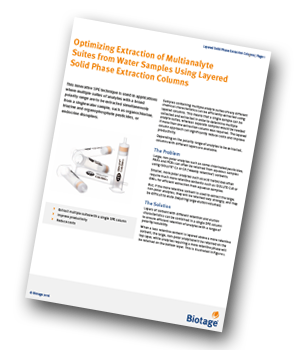Biotage has produced an application note demonstrating an innovative SPE technique that is used in applications where multiple suites of analytes with a broad polarity range are to be extracted simultaneously from a single water sample, such as organochlorine, triazine and organophosphate pesticides, or endocrine disrupters.
 The Problem
The Problem
Large, non-polar analytes such as some chlorinated pesticides, PAHs and PCBs can often be retained from aqueous samples using ISOLUTE® C2 or C8 (‘weakly retentive’) sorbents. Smaller, more polar analytes such as acid herbicides often require much more retentive sorbents such as ISOLUTE C18 or ENV+ for efficient extraction from aqueous samples. But, if the more retentive sorbent is used to extract the large, non-polar analytes, they will be retained very strongly, and may be difficult to elute (requiring large elution volumes).
The Solution
Layers of sorbent with different retention and elution characteristics can be combined in a single SPE column to ensure efficient retention of analytes with a range of polarity/solubility. When a less retentive sorbent is layered above a more retentive sorbent, the large, non-polar analytes will be retained on the top layer, while analytes requiring a more retentive phase will be retained on the bottom layer.
Application Example
The layered column approach was applied to the extraction of a broad range of organic pollutants from drinking water, including acid herbicides, base-neutral herbicides, PAHs, phthalate esters and phenolic compounds.
This application note will explain how to:
- Extract multiple suites with a single SPE column
- Improve productivity
- Reduce costs




